Advanced flower parameters
The parameters in the Primary flowers, advanced section could just as easily have been in the Primary flowers section, but there are an awful lot of them and they aren’t necessary on every plant. These parameters deal with optional floral parts which not all plants have. A flower with all the floral parts PlantStudio can draw looks like this:
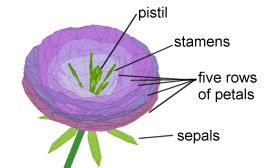
A secondary flower with all the floral parts PlantStudio can draw looks like this:
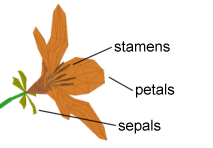
Note that there is no “advanced” section for secondary flower parameters because there are far fewer of them.
Pistils
Pistils are the female organs in a flower. They can be placed on primary flowers only. Each pistil consists of a style (stalk) and a stigma, the receptive surface to which pollen attaches. The flower’s ovaries are found at the base of the pistils (we don’t draw them). Typically you will want to draw the stigma in the same way you draw a fruit or bud in PlantStudio, with a few “section” 3D objects spun around to make a solid-looking object.
Stamens
Stamens are the male organs in a flower. They can be placed on primary or secondary flowers. Each stamen consists of a filament (stalk) and an anther, which holds the pollen. As with pistils, you will often want to include multiple 3D object sections in anthers to create a rounded object.
Second, third, fourth, fifth rows of petals
After the first row of petals, primary flowers can have four additional rows of petals. These work exactly like the first row, only you will usually want to array them with increasing values for the parameter Primary flowers, advanced: Angle between X-row petals and main stem (where X is the flower row) so that they open out gracefully.
One thing you can do with the five rows of petals is use them to produce flowers with non-symmetrical petals, like orchids: place only one or two petals in each row, and use the rotation parameters to position the petals so that they assume the positions you want.
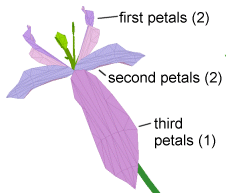
Sepals
Sepals are the outside covering structures found on some flowers. They are usually green, though in some cases they can be brightly colored and act like petals. Some flowers have a bulb under them, and you can use the sepals to act like that bulb by arching them back to form a rounded structure. (In that case, use the fifth row of petals as sepals.)
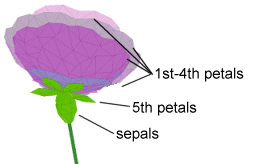
Flower bud
You can draw flower buds in any of three ways. The flower can just appear on the plant with no preceding bud; or you can draw a distinct bud stage with a 3D object (usually spun round like a fruit or meristem); or you can have the flower “open up” as it matures. This usually only takes a few days, but it can produce some interesting-looking flowers.
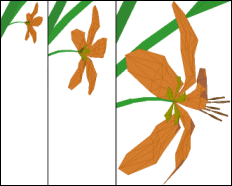
Created with the Personal Edition of HelpNDoc: Full-featured Documentation generator